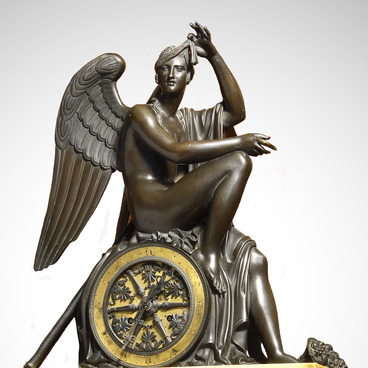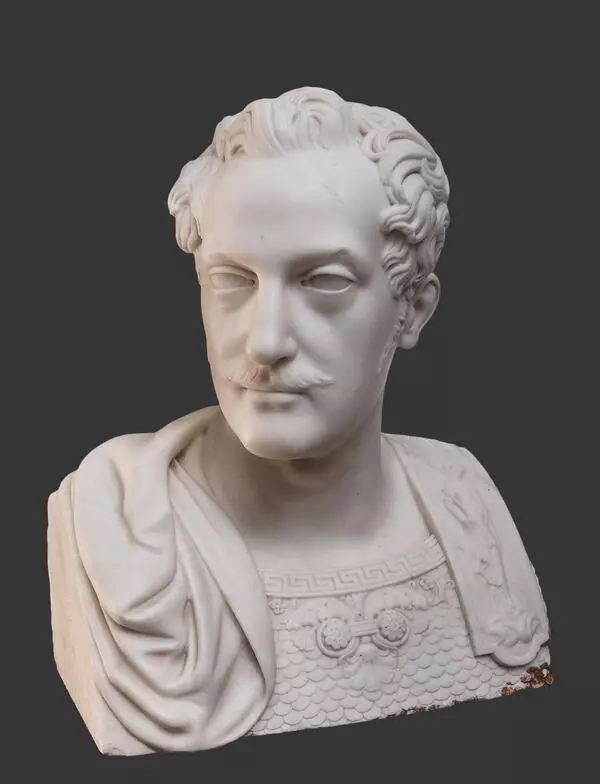A reduced copy of the monument in the form of a table sculpture was previously in the Odessa House of Vorontsov. The field marshal’s left palm is faced forward, while his right hand is clutching the sword. The face of the military commander does not express emotions, it is concentrated, eyes are looking down. He’s wearing a wide, antique-like coat. His coat is open on the chest, revealing a kind of body shirt with ornamented edge. Blücher’s right leg is forward, there’s an oak trunk with cut-off branches behind his left leg.
Gebhard Leberecht von Blücher was a Prussian field marshal who participated in the wars against revolutionary and then Napoleonic France. While sarcastic Napoleon called Blücher ‘le Vieux diable’ - ‘The Old Devil.’ In early 1813, Blücher was appointed to the position of Commander-in-Chief of Prussian forces which later became joined Russian-Prussian forces in Silesia. Blücher was awarded the title of Field Marshal General for the generalship in the ‘Battle of the Nations’ near Leipzig. He played a main role in the capture of Paris on 30-31 March 1814, and a year later in the Battle of Waterloo, which meant Napoleon’s final defeat. Blücher monuments are installed in several cities, including Berlin and Rostock.
The sculptured image of von Blücher was created by Christian Daniel Rauch, founder of the Berlin Sculpture School. The creative career of the young sculpture was successful and drawn attention of Queen Louise of Prussia. It was the Queen who sponsored Rauc 's training in Italy in 1803-1811.
In Italy Rauch learned from the masters - Kanova and Thorvaldsen, he learnt the art of carving on Carrara marble. Having reached high level of experience, he completed several grand monuments, one of them is the Queen Louise Mausoleum in Charlottenburg. Rauch installed a horse monument to the monarch of Prussia, Frederick the Great in Berlin. He also made statues of famous military leaders - York and Gneisenau. One of the sculptor’s best creations is a monument of the philosopher Immanuel Kant in Königsberg. Rauch also worked for the Russian Imperial House: he created sculptures of Alexander I and Nicholas I.
Gebhard Leberecht von Blücher was a Prussian field marshal who participated in the wars against revolutionary and then Napoleonic France. While sarcastic Napoleon called Blücher ‘le Vieux diable’ - ‘The Old Devil.’ In early 1813, Blücher was appointed to the position of Commander-in-Chief of Prussian forces which later became joined Russian-Prussian forces in Silesia. Blücher was awarded the title of Field Marshal General for the generalship in the ‘Battle of the Nations’ near Leipzig. He played a main role in the capture of Paris on 30-31 March 1814, and a year later in the Battle of Waterloo, which meant Napoleon’s final defeat. Blücher monuments are installed in several cities, including Berlin and Rostock.
The sculptured image of von Blücher was created by Christian Daniel Rauch, founder of the Berlin Sculpture School. The creative career of the young sculpture was successful and drawn attention of Queen Louise of Prussia. It was the Queen who sponsored Rauc 's training in Italy in 1803-1811.
In Italy Rauch learned from the masters - Kanova and Thorvaldsen, he learnt the art of carving on Carrara marble. Having reached high level of experience, he completed several grand monuments, one of them is the Queen Louise Mausoleum in Charlottenburg. Rauch installed a horse monument to the monarch of Prussia, Frederick the Great in Berlin. He also made statues of famous military leaders - York and Gneisenau. One of the sculptor’s best creations is a monument of the philosopher Immanuel Kant in Königsberg. Rauch also worked for the Russian Imperial House: he created sculptures of Alexander I and Nicholas I.





